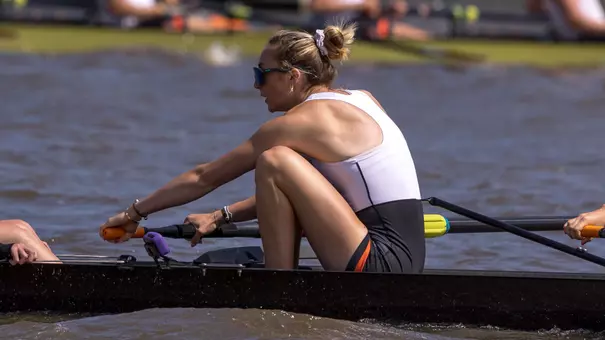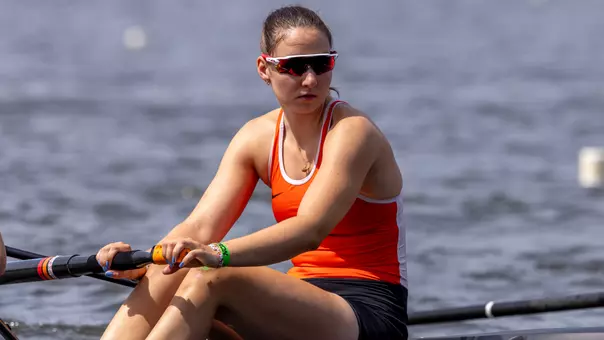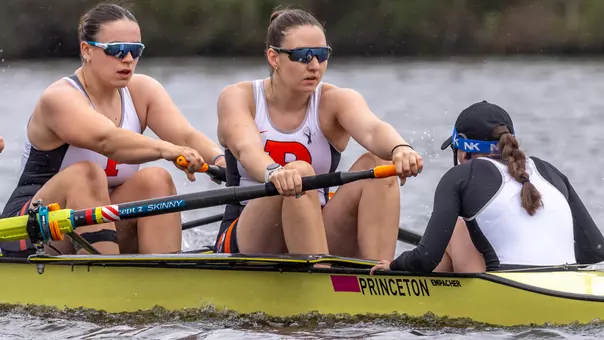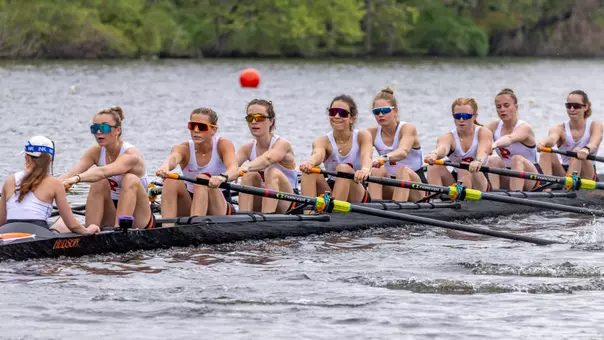Princeton University Athletics
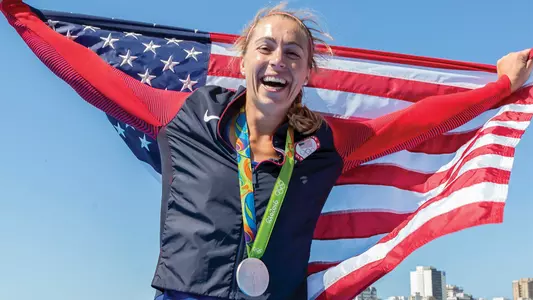
Rowing Celebration Feature: Silver Oars
March 31, 2022 | Women's Rowing - Open, Women's Rowing - Lightweight
It is March of 2021. Lauren Wilkinson has had a busy week with the Vancouver Coastal Health Authority, as a lead in the Covid-19 Response Team for one of the largest health authorities in British Columbia. A microbiologist and educator, she often rows before work. Now, on a Zoom call, she is holding her finger up to the camera, revealing a blood blister, a nasty one at that. It looks painful. To her, and to those who have done what she has done, the blood blister is a badge of honor.
Meanwhile, nine time zones to the east, Andréanne Morin is impressed, and probably a bit envious. Morin is in Paris, where she is a lawyer, wife, and mother of two. A French-Canadian by birth, she fits in nicely there.
At the same time, Gevvie Stone is in a third different time zone. She’s in a car driving north out of Florida, heading back to her home in Boston. Blood blisters are hardly going to freak her out. She’s Dr. Gevvie Stone, an emergency medicine doctor, one who spends a great deal of time in the ER.
For the three of them, though, there will always be something about a boat on a river that will make them feel right at home, whichever time zone they’re in. And blood blisters on their fingers? That will take them back to the hours and hours they spent with oars in their hands, in their home-away-from-home boats, trying to move them faster and faster down the river.
Their achievements in the sport of rowing are extraordinary, both at Princeton and on the international level. Morin and Stone were teammates on Princeton’s 2006 NCAA championship first varsity eight. Wilkinson and Morin were teammates on Canada’s 2012 Olympic silver medal eight. Wilkinson, a year earlier, won an NCAA championship of her own at Princeton. Stone, one Olympic cycle later, won a silver medal of her own, in the single sculls. That’s three Princeton women, each with an NCAA championship and each with an Olympic silver medal. The 2021 Olympic pairs qualification for Stone ran the total of Olympic appearances for the three of them to eight: three each for Morin and Stone and two for Wilkinson.
“Being surrounded by strong women at Princeton has helped all of us,” Stone says. “They were determined, competitive groups.”
“For me, what I loved about Princeton is that, yes, the women’s rowing program is very successful, with a lot of history, but for me, the big difference was the collegiality of everyone on the team,” Morin says. “People just cheered for each other. They cheered for you on the ergs. We trained together. We ate together. We went out together. It was very much the sense of belonging to a family.”
Stone and Morin were part of one of the greatest college boats ever, Princeton’s perfect 2006 crew. Wilkinson’s national championship team five years later wasn’t quite as dominant, but still is among the best Princeton has ever had. They came to Princeton in very different ways.
Morin was there first, when in the fall of 2000 she became the first freshman to row in the first varsity eight. She was already an established rower who had competed in the Canadian junior program, reaching two junior World Championships, though rowing was not her best sport as a kid. She grew up in Montreal, where she played team sports like basketball and volleyball. Mostly what she did was ski.
She started when she was six. Within ten years she’d established herself as a top junior skier, competing in provincial championships – until she hit a gate on a downhill run and shattered her leg at a 45-degree angle.
“The bones were at a diagonal,” she says. “They had to straighten it out. It’s not unusual for a skiing injury. At that age, it made me a bit more fearful on the hill. I wasn’t skiing with the same fight after that. Plus, I’d had a lot of knee problems due to a growth spurt. My knees would give way, and I couldn’t do running sports anymore. My father suggested I try a sport where I could sit.”
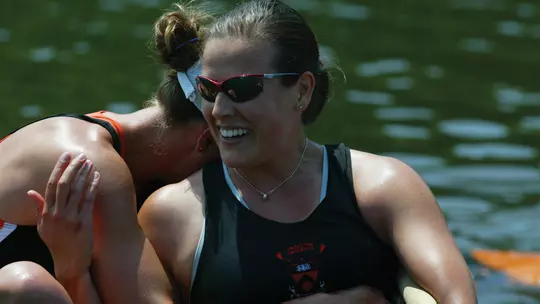
She had attended an English-speaking all-girls school in Canada, and from there she went to Phillips Exeter for her last two years of high school. She came to Princeton and after making history as the first freshman in the first varsity eight, she made the Canadian senior national team. That summer, and the following summer, she rowed for Canada at the World Championships. By the spring of 2003 she had her eye firmly on the Olympic Games, and so she withdrew from school so as not to miss that cycle. She’d end up on the Canadian team for the Athens Games in 2004, and she was back in school after taking off three semesters.
Because of that, she found herself as a second-semester senior in the spring of 2006. Stone was a junior on that team. She came from a rowing family, with her mother Lisa on the 1976 Olympic team and her father Gregg a two-time World Championship medalist who would have rowed in the 1980 Olympics were it not for the boycott. She rowed on the 2005 Princeton team that finished second at the Eastern Sprints, shockingly, to Yale by more than two seconds, and then again to California at the NCAA championships after spending most of the year ranked No. 1 nationally while going unbeaten.
If that season didn’t go as hoped, the 2006 season was simply perfect. First, Morin was back in the boat after taking off spring of 2005 after rowing in the Olympics. Second, there was more than just Stone and Morin. In all there were an astonishing four Olympians in the eight seats for head coach Lori Dauphiny, including two-time gold medalist Caroline Lind and Kate Bertko. There was no team who could match up with Princeton, at least no women’s team.
“The most fun race we had was against our men’s lightweights,” Stone says. “That showed how much our team really loved a challenge. We wanted to go fast. That’s something that has stuck with me through the years. We had a true love of rowing. We loved the challenge. Lori was such a huge part of that. She knew how to push all of us to our limits. I’m forever grateful to Lori. I’d always been competitive. She made me more of a fighter. She unleashed that inside of me.”
Princeton literally raced past every competitor in 2006, going unbeaten in fourteen regular season races. With the memory of 2005 firmly embedded in those who had been there, Princeton put up epic numbers at the Eastern Sprints, defeating second place Brown by just under eight seconds in the first varsity eight final.
The first varsity eight race at the NCAA championships two weeks later on the essentially hometown Mercer County Lake wasn’t much more competitive. Princeton led by a half-length after 1,000 meters and by a full length with 500 to go before reaching the finish line 6.4 seconds ahead of second-place California.
“We knew we had a bullseye on our back,” Morin says. “We knew we were the favored crew going in and there was pressure to deliver. For us, though, it was always ‘okay, let’s push the limits. Let’s get open water sooner.’ It was never enough. Lori always said that you never know what could happen and that we needed to get as far ahead as possible. That’s what we just loved, getting out there. Getting out in front. When we were at NCAAs, we wanted to push ourselves to the potential that we knew we had.”
While the 2006 women’s open rowing team was destroying its competition, Lauren Wilkinson was in high school in British Columbia. Also part of a rowing family (her brother Michael would row for Canada in the Olympic Games as well), she began rowing when she was eleven, starting out in a club on Burnaby Lake, where she rowed singles and was coached by a former Canadian Olympian. Wilkinson was the top junior women’s sculler in Canada for her last two years of high school and raced for Canada at two Junior World Championships.
“Growing up, I loved playing what you’d call ‘game’ sports,” she says. “It’s funny that I ended up with rowing. My brothers were rowing, and I used to get to run around the lake while they did. Eventually I figured it would be more fun to be in the boat.”
When it came time to choose a college, she drew on two experiences that had been, literally and figuratively, driven by her father. First, when she was around six years old, her parents had gotten a new car, and her father told her that if she grew up and went to an Ivy League school, he’d get her a pink Cadillac. Second, when she was in high school, her father was teaching at the University of British Columbia, with 45,000 undergrads on the Vancouver campus.
“I had an idea what a larger undergraduate academic experience would be like,” she says. “I was looking for a smaller school, and for a top rowing program. I knew Princeton was an academic and rowing powerhouse from reading rowing magazines. I built up the Princeton experience as something I was going to try for. When I got in, my father got me a toy pink Cadillac.”
Princeton went from winning the 2006 NCAA title to finishing sixth, twelfth, sixth, and then third in 2007 through 2010. The 2011 season was Wilkinson’s senior year and her final shot at a championship. Much like the 2006 Tigers, the 2011 crew had to deal with the memory of the year before, when an unbeaten regular season turned into an Eastern Sprints loss to Yale. The final in the 2010 Eastern Sprints had Yale ahead of Princeton by 0.77 seconds. The third-place team that year was Brown, which finished more than
ten seconds behind Princeton. Like the 2006 team, Princeton didn’t leave anything to chance in 2011, winning Eastern Sprints by open water over Brown, who was more than four seconds behind at the finish. Yale, by the way, was fourteen seconds behind Princeton.
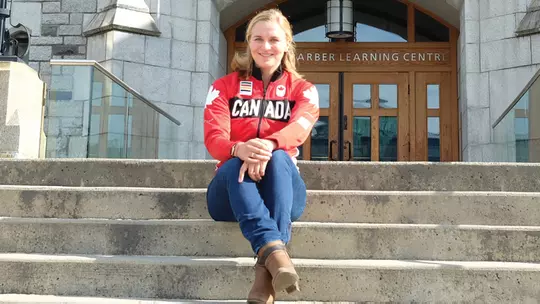
On the other hand, the 2011 NCAA championship regatta was a much different story than in 2006. For starters, instead of being around the corner from the Princeton campus, the regatta was held in Sacramento, 3,000 miles away. Second, Princeton, which led at the 1,000-meter mark, fell behind California at one point before pulling even, then slightly ahead with 500 meters to go. From there, it was all Princeton, who won by 1.5 seconds.
“It was building for four years,” Wilkinson says. “We went from completely out of medal contention to eventually first. The final was a very controlled race. Going into the final, we had the confidence and trust in each other so that I knew we were going to win. Ariel Frost, our coxswain, she said that there was always a tipping point. There was a point where you made a decision as a crew that you wouldn’t give up, you knew you wouldn’t break. You’d make the other crew break before you did. I just remember that race in particular, one of the only times in my life in a boat that big that I had an absolute trust in every other person in the boat. We would have walked through fire for each other. We would die for each other. If we maintained that, there was no way we could lose. Even when we were behind, I knew we were going to pass them and win.”
A year after Wilkinson’s NCAA win, she and Morin would team to win silver with the Canadian eight at the London Olympic Games, just over a second behind a U.S. boat that featured Princetonian Lind. Wilkinson would return to the Olympics in 2016 as well, finishing fifth in Rio, again with the Canadian eight.
Stone and Morin had to balance their Olympic rowing careers with their post-graduate educational pursuits. Morin went to law school at the University of Montreal, attending from 2008-10 and then returning to finish after the London Games, her last foray into international rowing.
Stone’s path was even more arduous. She didn’t qualify for the 2008 Olympics and then began medical school at Tufts, going for two years through 2010. She then took a leave to train for the 2012 Olympics, in which she would win the B final to finish in seventh in the singles. Then it was back to medical school, graduating in 2014.
“There’s a natural divider between your first two years of medical school and the next two,” she says. “I took the Step 1 board exams. Then I took off, and when I came back, the toughest part was the culture change. I went from being an Olympic rower to being a third-year medical school student. That’s the lowest on the hospital ladder. But then it was just as hard to leave the hospital and go back to rowing. I love them both, and some things are great about both. At the same time, there are also real challenges about both.”
She did manage to balance the demands of residency with rowing, with some weeks where she was barely able to get out and others where she could do 90-minute workouts five days a week. She also raced at the Head of the Charles annually, something she’s won a remarkable ten times.
Stone returned to the Olympics in 2016, again in the singles. This time, she won her heat and her quarterfinal. Needing to finish in the top three in the semifinal to reach the final, she came in second behind China’s Duan Jingli. Then she won the silver, beating Jingli by more than a second and finishing a half-second behind Australia’s Kim Brennan. The picture of Stone after her final race, wrapped in the American flag, is one of the purest joy.
“I was incredibly nervous before the final,” Stone says. “I thought I’d finish second, third, or fourth. When I crossed the line second, that was the best I could have imagined. It was such an incredible moment to have. After 2008 I didn’t think I’d ever be fast enough to make the Olympics. After 2012, I didn’t think I’d ever be able to make the final. To have a result like the silver medal, to make the podium, that was a moment I thought I’d never have. There was no way to put it into words. It was a dream come true.”
“I’m super proud of my Olympic silver medal,” Morin says. “For me it was twelve years in the making, and that’s not an insignificant amount of time. But I think what I’m really proud of is having never given up on my education. Princeton was such an important milestone for me. For me, it was about being able to win the NCAA championship while doing a senior thesis during this incredible university experience with a world-renowned coach and some phenomenal professors. When I’m asked to speak to kids, my constant message is don’t give up on school because of sports. You’re always one stroke away from a herniated disc. You’re one ski turn away from a broken leg. You need a Plan B. For me, Princeton was an amazing accomplishment.”
“There’s only a short period of time where you are at Princeton,” Wilkinson says. “Your time with that group of women is precious. When you are out of the boat with the national team, you’re not really so much a part of a team. At Princeton, unlike the national team experience, when you’re rowing for your university, even if you’re in the 3V or 4V, you’re as much a part of the team as anyone. Everyone is contributing. There’s definitely a camaraderie there. It’s one of the best rowing experiences I ever had and some of the most fun I’ve ever had. When you train and eat together and party together, you get to see people be tested. I remember we did a lot of pretty hard winter erg sessions, but you push through and finish that piece or do an extra piece because you don’t want to let your teammates down. We’d do the same thing on the water. My senior year was a bit of a ride, doing a senior thesis, and on top of that, you have this other goal. It’s a time in your life when you’re pushed mentally and athletically, and you’re riding an edge and pushing yourself in both areas. You never feel so alive.”
— by Jerry Price
This story was the prologue in the book “I Can Do Anything … Stories From The First 50 Years Of Women's Athletics At Princeton.” The book can be ordered HERE.





